Ancient Egyptian human sacrifice
Human sacrifice in 1st Dynasty Egypt (c. 2950–2775 BCE) is a hypothesis that during the very early stages of Dynastic Egyptian history, the Pharaohs of the 1st Dynasty practised human sacrifice, having courtiers or high officials kill themselves (or be killed) so that they could be buried in the Royal tomb and thus continue to serve the Pharaoh in the afterlife. There is, however, very little evidence that anything like this actually happened. The discoveries at Abydos are indeed somewhat unusual, but the fact remains that there are no indicators of a cultural preference or tolerance of human sacrifice in Egyptian literature and beliefs, and absolutely no evidence at all at any point from the 2nd Dynasty onwards, nor is there any indication of such a practice occurring in the pre-dynastic cultures that existed immediately prior to the unification of Egypt. Therefore, the evidence claimed for human sacrifice in the 1st Dynasty must be evaluated in the context of an otherwise remarkably consistent culture that otherwise shows no inclination to such acts at any time or place for a period of 3000 years after this find, no trace of such acts in the cultures immediately preceding it, and nothing more than speculative evidence for such practice at a single time and location.
| Preach to the choir Religion |
| Crux of the matter |
| Speak of the devil |
|
| An act of faith |
|
v - t - e |
Given this, human sacrifice at Abydos cannot be dismissed as complete bullshit, but those seeking to publicise it are pushing very scanty evidence to the extreme limit of credibility, and presenting it as a "cut and dried" case when the evidence in no way supports such a definitive judgement.
Background of Abydos
Abydos (from Egyptian: 3bdw, possible translation: "Hill of the symbol/reliquary")(location: 26° 11′ 5.5″ N, 31° 55′ 7.96″) is one of the oldest monumental sites of Upper Egypt, in use from the Pre-dynastic to the Greco-Roman periods (a span of 3500-4000 years), and is one of the most important archaeological sites in the country. A number of ritual, mortuary and settlement structures have been excavated, most notably, Seti I's well-preserved temple containing the famous "King list", along with the infamous Abydos helicopter, and the Osireion, a New Kingdom structure notable for its archaising design elements. However, It is the Early Dynastic Royal Necropolis, with Royal burials and associated structures of the 1st Dynasty that is of significance to this article.
History of the theory
The theory was first postulated at the very end of the 19th century CE, during excavations of the Pre- and Early-Dynastic cemetery by Petrie (1899–1900).[1] However, whilst Petrie mentioned the possibility of human sacrifice in the tombs of Aha and Djer, he explicitly noted that the evidence was too tenuous to say with any certainty at all as to whether the subsidiary burials within the Royal tombs were sacrificial, or simply those of officials who had served the Pharaoh and were given a tomb within the Royal complex as reward. Thus, the matter was largely forgotten in Egyptology, and with no other evidence for such practices anywhere else in Egyptian culture the issue received only a passing mention in most works, including in Emery's extensive work on the Pre- and Early-Dynastic era, "Archaic Egypt".[2] The subject of sacrifice became more of a curious insight into how theories were developed in 19th century archaeology than it was into Early-Dynastic concepts of the Royal afterlife.
However, in recent times, the growth of media-driven archaeology, particularly in relation to Pharaonic Egypt, has brought renewed interest in the theory, and amidst much sensationalism has promoted the theory from a throw-away 19th-century comment to historical "fact". Between 2000 and 2003, the University of Pennsylvania conducted excavations in Abydos aimed at re-excavation of the Early-Dynastic Royal cemetery, with the goal of answering questions concerning the so-called "forts" located nearby, which it was expected could be shown to be mortuary cult temples, or something similar. Whilst this was done, further excavation of the Early-Dynastic enclosures have brought to light more subsidiary graves, and more sophisticated analysis of the burials, providing ample fuel for a high profile media spotlight on so-called "human sacrifice". National Geographic quickly ran with the story[3][4] which soon took on an increasingly bizarre life of its own,[5] but did bring welcome light to what had been a fruitful and valuable archaeological mission, albeit a somewhat hijacked one.
Archaeological evidence
Subsidiary burials
Archaeological evidence for this practice is based almost entirely on subsidiary graves attached to the Royal tombs of the 1st Dynasty from Aha onward. Although burials of courtiers and members of the Royal family are found surrounding Royal tombs of other periods, there is no question of human sacrifice ever having been involved in these cases. Similarly, suggestions of evidence of human sacrifice does not appear prior to Aha, nor after the 1st Dynasty. As such it is suggested that this practice appeared suddenly, shortly after the founding of the Pharaonic state, then promptly died out, regardless of the fact that the custom of burying high officials in satellite tombs surrounding the Royal mortuary complex continued well into the Middle Kingdom. The table below details all Royal burials that contain suspected "sacrificial" burials in either the Royal burial itself or associated mortuary enclosure (where identified). All burials are from the 1st Dynasty, and all from Abydos.
| Pharaoh | Length of Reign | Tomb Burials | Enclosure Burials | Notes |
|---|---|---|---|---|
| Aha | 32 | 35 | 6 | First occurrence of "sacrificial" burials. A label dating from his reign may also depict "sacrificial" scenes. |
| Djer | 41 | 317 | 42 | Largest number of burials. Also a wooden label from Saqqara, containing Djer's name, has images that may be interpreted as depicting a sacrifice. |
| Merneith | Disputed | 41 | See note | Disputed whether or not she ruled in her own right. May have shared the enclosure of Den, who is likely to be her son. |
| Djet | 23? | 174 | 161 | Reign length suggestion based only on Manetho. |
| Den | 32 | 133 | 77 | Enclosure may be shared with Merneith. |
| Anedjib | 10 | 64 | ? | Both Royal and subsidiary tombs of low quality. Troubled reign? Enclosure not located. |
| Semerkhet | 9 | ? | ? | Possibly usurped the throne. Very high quality burial, however. Enclosure not located. |
| Qa'a | 26 | 26 | ? | Last burial suspected of having included "sacrifice". Enclosure not located. End of 1st Dynasty |
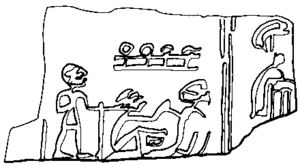
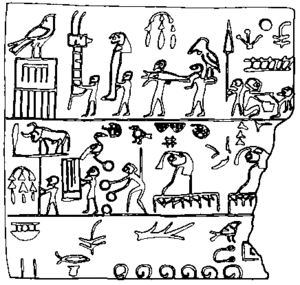
Labels depicting the act of "sacrifice"
Two labels have been recovered, dating to the reigns of Aha (aka Hor-Aha) and Djer, both containing similar iconography that it is claimed depict the ritual killing of human beings. That of Hor-aha is in fragmentary condition, and only part of the entire scene is preserved. The scene shows two men sitting or kneeling, one piercing the other with a pointed object, with a bowl between them. The one being pierced is bent backwards.
This scene is replicated in the top right hand corner of the more complete label of Djer, recovered from Saqqara. Both scenes have an a sign above them resembling, to the modern eye, a fence, though it's meaning (or even what it depicts) is uncertain.
Based on these depictions, it would appear that the person to be sacrificed was bled to death, and that the blood was collected. However, this is in contradiction with the human remains discovered, where signs of violence are not present on the skeletal remains. Stabbing to draw to blood, especially with a large object, will leave cut marks or impact damage upon the skeleton, which has not been present on surviving remains.
Rather, poisoning has more traditionally been advanced as the method of sacrifice, though Dr. Nancy Lovell (Professor of Anthropology, University of Alberta[9]) believes that strangulation was a possibility, based on a study of dental remains from the subsidiary burials of Hor-Aha.[10]
It is possible that more than one method was used at different times, or that the ritual sacrifice of certain individuals was a separate practice to that of retainer sacrifice, and that such acts were part of other rituals or festivals, as suggested by Kinnaer on his personal website.[11] However, there is no mention anywhere in Egyptian literature of such acts being part of any religious ritual or festival at any period in Dynastic history, and there is no other evidence of this at all. As such, to make this leap is pushing extremely fragmentary evidence to the very limits of its credibility.
Furthermore, several scholars have disputed that the labels depict sacrifice at all. Rather, they interpret the images as depicting the work of physicians, pointing to their unique nature. Whilst images or even mention of putting people to death in Egypt are extremely rare, where it does occur bleeding is not amongst them. It is also strange that such an act would be conducted with the executioner in a kneeling or sitting position. In light of this, the suggestion that we are witnessing a medical procedure rather than ritual sacrifice (either individual ritual sacrifice, or retainer sacrifice) is much more in keeping with evidence from other periods and the general trend of Egyptian culture.
Claims of literary allusions
Those in support of the claims of Early Dynastic sacrifice (and also "Pre-dynastic cannibalism") point to certain tracts within the Pyramid Texts as making allusions to sacrifice and cannibalism from earlier periods. Chapters 273 – 274 do portray the Pharaoh as eating the bodies of the gods:
- For they have seen the King appearing in power
- As a god who lives on his fathers
- And feeds on his mothers[12]
- The King is the Bull of the sky,
- Who conquers(?) at will,
- Who lives on the being of every God,
- Who eats their entrails(?),
- Even of those who come with their bodies full of magic
- From the island of fire. [12]
- The King is one who eats men and lives on the Gods [12]
- It is the King who eats their magic
- and gulps down their spirits;
- Their big ones are for his morning meal,
- Their middle-sized ones are for his evening meal,
- Their little ones are for his night meal[12]
However, these chapters are unique not only within the Pyramid Texts, but within Egyptian literature, and nowhere else are such concepts touched upon. In addition, its focus primarily on the deceased Pharaoh within the realm of the Gods, emphasising his power over them (with the exception of Ra, with whom he is associated), and gaining access to the celestial realm and the solar barque.[13] As such, and more in keeping with Egyptian literary culture, belligerent or aggressive language, and boasting of martial prowess are often used in context of justifications and claims to status and rights both in both the earthly and heavenly realms, and such claims should never be taken at face value.[14]
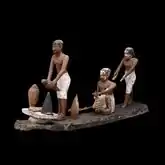
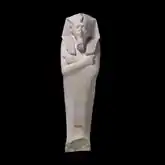
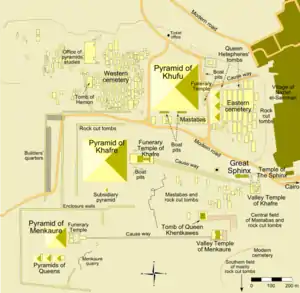
Later dynastic culture
Worker models/statuettes
Later in the Dynastic Period, there is extensive archaeological evidence of models of workers of various professions included amongst the grave goods of the deceased, and are attested from the Fourth Dynasty onward,[15] and become extremely widespread from the First Intermediate Period onward.[16] It has been suggested that these statuettes or models are the symbolic replacement for the sacrificed retainers of the First Dynasty, yet this raises some important points:
- This hypothesis encounters a significant chronological gap, as evidence for statuettes and models is lacking from the 2nd and 3rd Dynasties, and though it is attested from the 4th, it is not until the First Intermediate Period (7th-11th Dynasties) that these models become widespread. This suggests their development was unrelated to the cessation of any kind of "human sacrifice", which is not attested beyond the end of the 1st Dynasty.
- The statuettes and models featured tend to be that of farmers, bakers, washers, porters etc., not the high officials (retainers) found in the subsidiary burials.
- These statuettes overwhelmingly come from private burials. Whilst there are far more private than royal burials, and the former are more likely to escape the attentions of robbers, it does not change the fact that whilst subsidiary burials overwhelmingly accompany royal burials, most of statuettes come from private ones.
Considered together, the evidence against the introduction of models or statuettes of workers being a symbolic development of earlier human sacrifice is worthy of note, and paints a picture much less clear cut and logical than is first suggested.
Shabti figures
During the Middle Kingdom, these statuettes/models were complemented by the shabti (or ushabti) figure, which were included, sometimes in their hundreds, and complete with "shabti overseers" in both private and Royal tombs.[17] Whilst the models/statuettes were of specific workers in specific professions (washer women, porters, farmers, bakers etc.), the shabti was generally not identified with any kind of work, and indeed according to the magical inscription generally painted or inscribed upon them, were intended to themselves answer any demands placed upon the deceased to work in the afterlife, on his behalf.[17] Thus it may be seen that the shabti is not a direct symbolisation of the supposed earlier role of the sacrificed retainer or courtier, but rather (or perhaps also), as a double for the deceased himself. Again, it must be emphasised that these figures did not develop until the Middle Kingdom, almost one thousand years after the reign of Qa'a.
Burials of officials in the Pyramid Age
The tendency of the Early Dynastic Egyptians to bury courtiers and high officials near to the tomb is a recurrent theme in Egyptian necropoli, and can most clearly be seen at Saqqara and Giza, where the Royal pyramids are surrounded by "towns" of mastaba tombs housing high officials, courtiers and the general "great and good" of Old Kingdom society. As there is no mention or suggestion at all of human sacrifice at either of these sites, the proximity or large numbers of lesser burials surrounding the tomb of the Pharaoh cannot be taken as evidence supporting an argument for human sacrifice at other sites, or in the preceding Dynasties. Such a layout is a recurrent theme in Egyptian burial practice, and entirely in keeping with Egyptian beliefs, without any reference to sacrifice.
Egyptian literature on the value of human life
Egyptian culture placed an extremely high value on life, and the taking of either one's own life or that of others is a recurrent theme in Egyptian literature. Texts of the Old and Middle Kingdom both portray a culture where taking the life of an innocent Egyptian is morally abhorrent.
- His Majesty said: "Is it true, what they say, that you can join a severed head?" Said Djedi: "Yes, I can, O King, my Lord" Said His Majesty: "Have brought to me a prisoner from the prison, that he be executed." Said Djedi: "But not to a human being, O King, my Lord! Surely, it is not permitted to do such a thing to the noble cattle!". A goose was brought and its head cut off.[18]
In addition the complex 12th Dynasty text "A Dispute Between a Man and His Ba" (P. Berlin 3024) deals extensively the ethics concerning suicide and death amongst non-royal Egyptians, and clearly shows that suicide (i.e. voluntary sacrifice) is considered to be abhorrent.[18]
See also
References
- Chronicle of the Pharaohs: The Reign-by-Reign Record of the Rulers and Dynasties of Ancient Egypt by Peter A. Clayton (2006) Thames and Hudson. New edition. ISBN 0500286280.
- Archaic Egypt: Culture and Civilization in Egypt Five Thousand Years Ago by Walter B. Emery (1961) Penguin Books. Emery excavated at Abydos intermittently from 1936 to 1956.
- Abydos: Life and Death at the Dawn of Egyptian Civilization by John Galvin (April 2005) National Geographic (archived from December 10, 2007).
- Human sacrifice in Ancient Egypt by National Geographic (Jan 27, 2008) YouTube (archived copy).
- http://videos.howstuffworks.com/hsw/21922-inside-the-pyramids-egyptians-and-human-sacrifice-video.htm
- Clayton, P A (1994), The Chronicle of the Pharaohs, Thames and Hudson, London
- Bremmer J.N (2007), The Strange World of Human Sacrifice: Studies in the History and Anthropology of Religion, Peeters, Leuven (Belgium)
- Archaeologists Discover Evidence That Courtiers Were Sacrificed To Accompany Early Egyptian Kings Into The Afterlife: Dig at Abydos Yields Important Discoveries About Egypt’s First Dynasty University of Pennsylvania Museum (archived from JUne 25, 2004).
- Nancy C. Lovell Department of Anthropology, University of Alberta (archive dfrom May 2, 2006).
- "Abydos: Life and Death and the Dawn of Egyptian Civilization" by J. Galvin (April 2005) National Geographic Magazine.
- Kinnear J, Human Sacrifice in Ancient Egypt at http://www.ancient-egypt.org/
- Faulkner, R O (1969), The Ancient Egyptian Pyramid Texts, Oxford University Press.
- Based on independent study of Faulkner’s 1969 translation
- Ancient Egyptian Literature. Volume II: The New Kingdom by Miriam Lichtheim (1976) University of California Press. ISBN 0520248430.
- The Treasures of Ancient Egypt: From the Egyptian museum in Cairo by Alessandro Bongioanni & Maria Sole Croce (2003) White Star. ISBN 8880952358.
- The Oxford History of Ancient Egypt, edited by Ian Shaw (2000) Oxford University Press. ISBN 0192804588.
- British Museum Dictionary of Ancient Egypt by Ian Shaw & Paul T. Nicholson (2008) British Museum Press. ISBN 0714119806.
- Three Tales of Wonder, Papyrus Westcar (P. Berlin 3033) - Lichtheim, M (1975), Ancient Egyptian Literature Vol. 1, University of California Press.